Radioactive Source Localisation via Projective Linear Reconstruction
Abstract
1. Introduction
1.1. The Nuclear Waste Problem
1.2. Radiation Mapping
1.3. Radioactive Source Localisation
1.4. Micro-Gamma Spectrometry
1.5. Collimation
1.6. Resolving the Issue of Radioactive Source Localisation
2. Method
2.1. Fitting the Detector Response Function
2.2. Kaczmarz Deconvolution Optimisation
2.3. Experimental Scenarios
3. Results and Discussion
3.1. Scenario 1—Two Sources
3.2. Scenario 2—Four Lower Activity Sources
3.3. Scenario 3—Proximity Limit
3.4. Scenario 4—Mixed Source Strengths
3.5. Quantitative Improvement Measure
4. Conclusions
Author Contributions
Funding
Institutional Review Board Statement
Informed Consent Statement
Data Availability Statement
Acknowledgments
Conflicts of Interest
Abbreviations
| PLR | Projective Linear Reconstruction |
| UAV | Unmanned Aerial Vehicle |
| DRF | Detector Response Function |
Appendix A
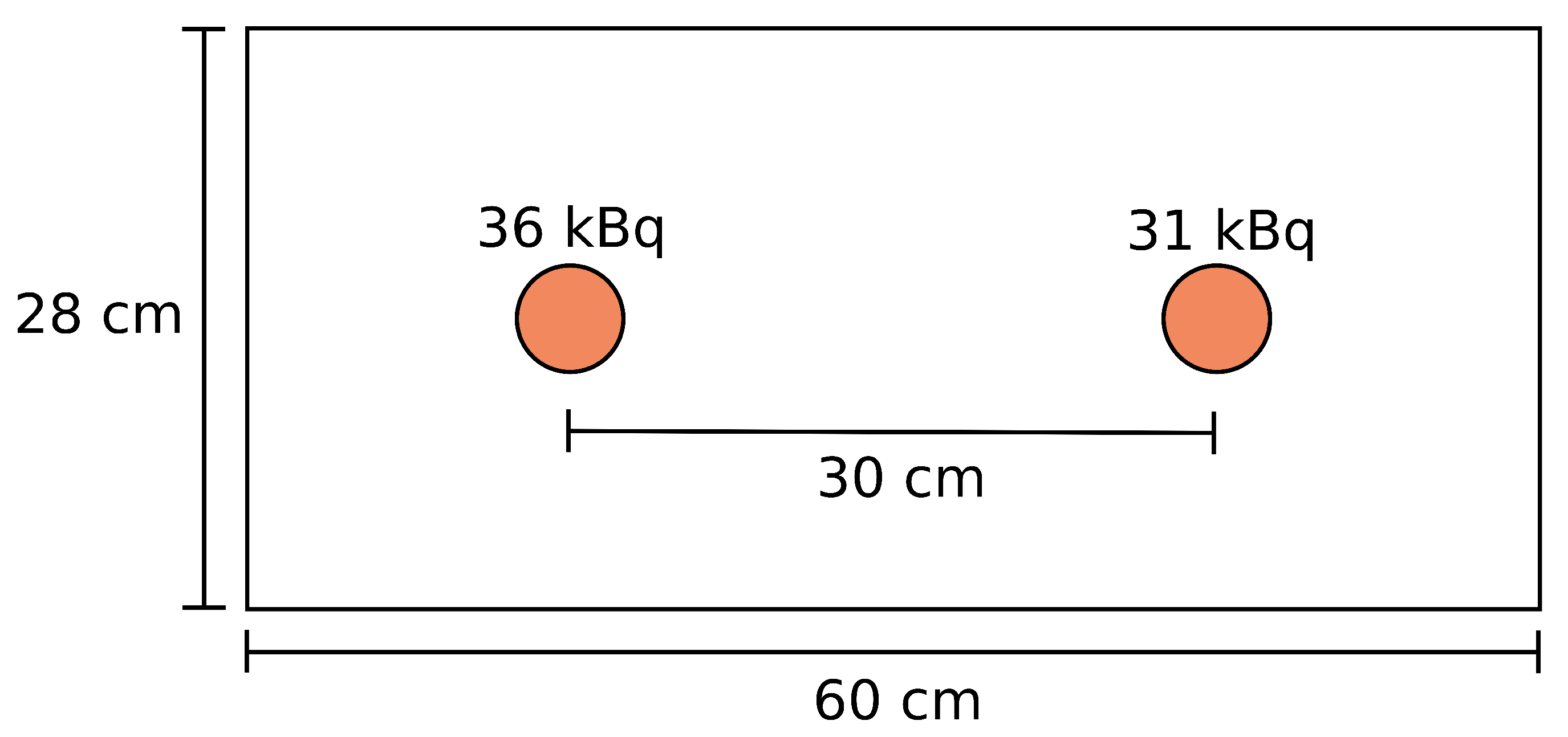

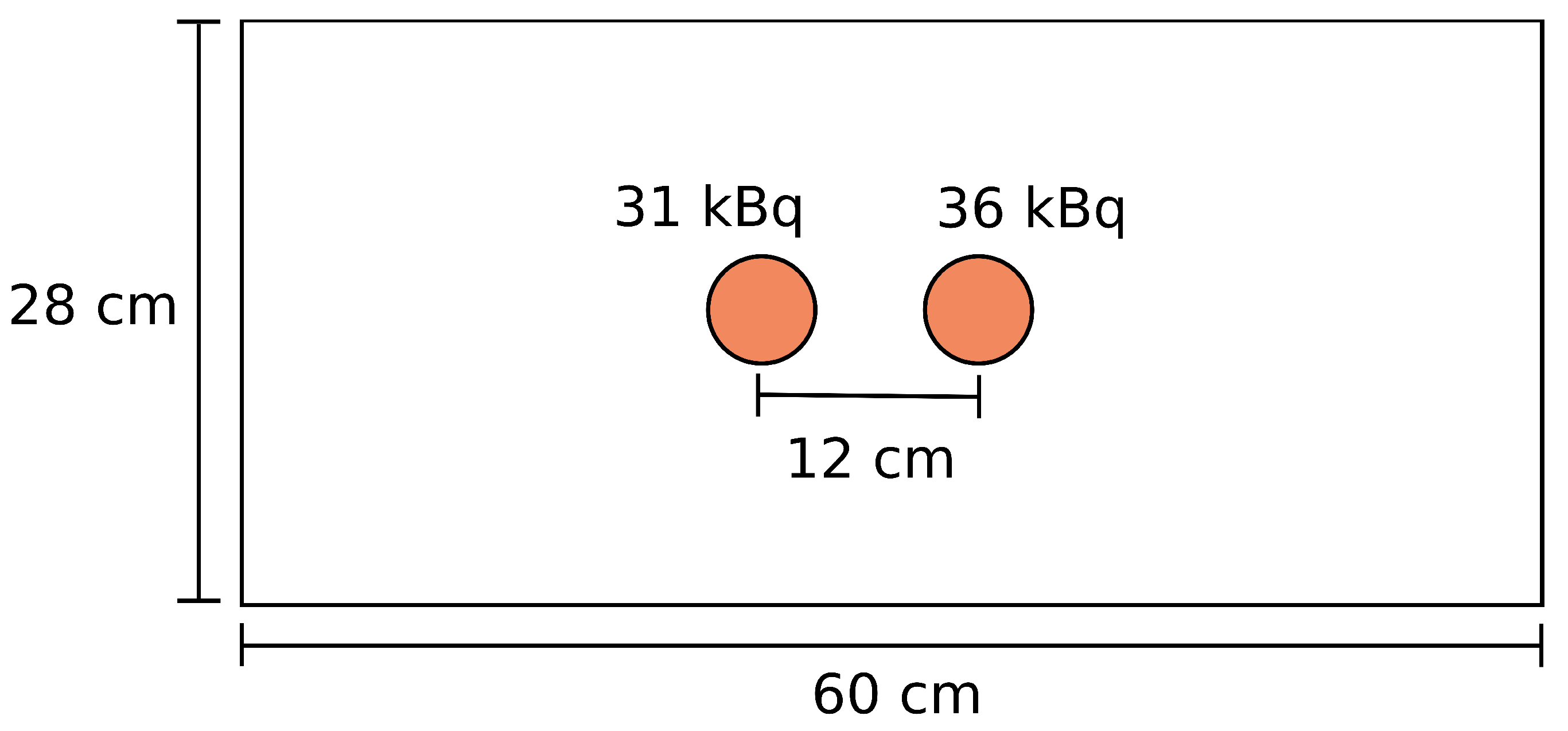
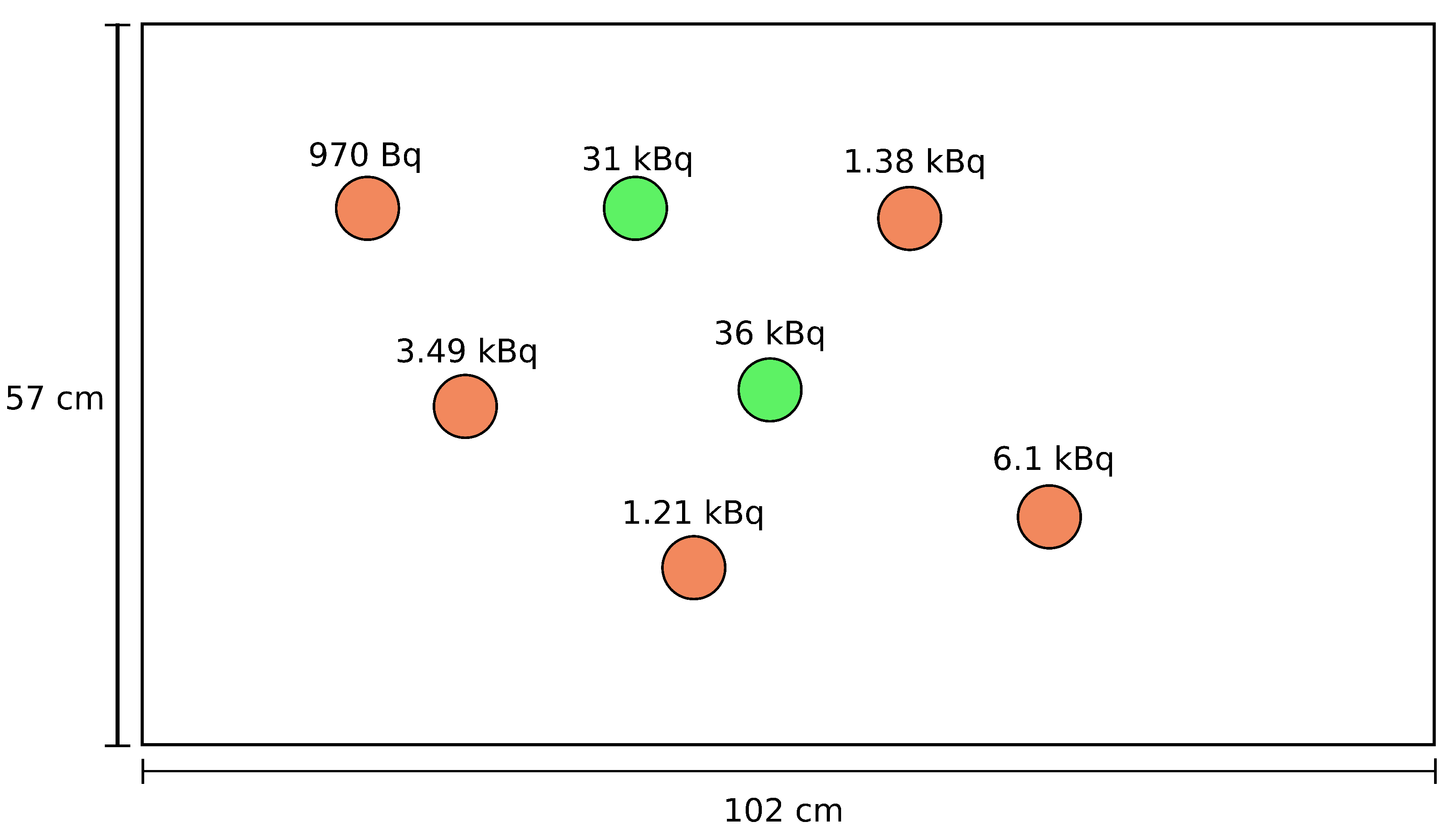
References
- UK Nuclear Decommissioning Authority. Nuclear Provision: The Cost of Cleaning up Britain’s Historic Nuclear Sites. Available online: https://www.gov.uk/government/publications/nuclear-provision-explaining-the-cost-of-cleaning-up-britains-nuclear-legacy/nuclear-provision-explaining-the-cost-of-cleaning-up-britains-nuclear-legacy (accessed on 26 January 2021).
- UK Radioactive Waste Inventory. Radioactive Waste Strategy. Available online: https://www.gov.uk/government/consultations/nda-radioactive-waste-management-strategy (accessed on 26 January 2021).
- UK Radioactive Waste Inventory. UK RWI Inventory Report. Available online: https://ukinventory.nda.gov.uk/ (accessed on 26 January 2021).
- Smith, R.; Cucco, E.; Fairbairn, C. Robotic Development for the Nuclear Environment: Challenges and Strategy. Robotics 2020, 9, 94. [Google Scholar] [CrossRef]
- Knoll, G. Radiation Detection and Measurement; Wiley: Hoboken, NJ, USA, 2000; Chapter 8. [Google Scholar]
- White, S.R.; Megson-Smith, D.A.; Zhang, K.; Connor, D.T.; Martin, P.G.; Hutson, C.; Herrmann, G.; Dilworth, J.; Scott, T.B. Radiation Mapping and Laser Profiling Using a Robotic Manipulator. Front. Robot. AI 2020, 7, 141. [Google Scholar] [CrossRef]
- Selivanova, A.; Hůlka, J.; Seifert, D.; Hlaváč, V.; Krsek, P.; Smutný, V.; Wagner, L.; Voltr, J.; Rubovič, P.; Češpírová, I.; et al. The use of a CZT detector with robotic systems. Appl. Radiat. Isot. 2020, 166, 109395. [Google Scholar] [CrossRef] [PubMed]
- Basso, A.; Hlaváč, V.; Hůlka, J.; Jilich, M.; Krsek, P.; Malassiotis, S.; Molfino, R.; Smutný, V.; Wagner, L.; Zoppi, M. Towards Intelligent Autonomous Sorting of Unclassified Nuclear Wastes. Procedia Manuf. 2017, 11, 389–396. [Google Scholar] [CrossRef]
- Boudergui, K.; Carrel, F.; Domenech, T.; Guénard, N.; Poli, J.; Ravet, A.; Schoepff, V.; Woo, R. Development of a drone equipped with optimized sensors for nuclear and radiological risk characterization. In Proceedings of the 2011 2nd International Conference on Advancements in Nuclear Instrumentation, Measurement Methods and Their Applications, Ghent, Belgium, 6–9 June 2011; pp. 1–9. [Google Scholar] [CrossRef]
- Ashley, S.; Vaughan, G.; Nuttall, W.; Thomas, P. Considerations in relation to off-site emergency procedures and response for nuclear accidents. Process. Saf. Environ. Prot. 2017, 112, 77–95. [Google Scholar] [CrossRef]
- Connor, D.; Martin, P.; Pullin, H.; Hallam, K.; Payton, O.; Yamashiki, Y.; Smith, N.; Scott, T. Radiological comparison of a FDNPP waste storage site during and after construction. Environ. Pollut. 2018, 243, 582–590. [Google Scholar] [CrossRef] [PubMed]
- Connor, D.; Martin, P.; Smith, N.; Payne, L.; Hutson, C.; Payton, O.; Yamashiki, Y.; Scott, T. Application of airborne photogrammetry for the visualisation and assessment of contamination migration arising from a Fukushima waste storage facility. Environ. Pollut. 2018, 234, 610–619. [Google Scholar] [CrossRef] [PubMed]
- Gabrlik, P.; Lazna, T. Simulation of Gamma Radiation Mapping Using an Unmanned Aerial System. IFAC-PapersOnLine 2018, 51, 256–262. [Google Scholar] [CrossRef]
- Martin, P.; Payton, O.; Yamashiki, Y.; Richards, D.; Scott, T. High-resolution radiation mapping to investigate FDNPP derived contaminant migration. J. Environ. Radioact. 2016, 164, 26–35. [Google Scholar] [CrossRef] [PubMed]
- Lemaire, H.; Khalil, R.A.; Amgarou, K.; Angélique, J.C.; Bonnet, F.; Toro, D.D.; Carrel, F.; Giarmana, O.; Gmar, M.; Menaa, N.; et al. Implementation of an imaging spectrometer for localization and identification of radioactive sources. Nucl. Instrum. Methods Phys. Res. Sect. A Accel. Spectrom. Detect. Assoc. Equip. 2014, 763, 97–103. [Google Scholar] [CrossRef]
- Carrel, F.; Khalil, R.A.; Colas, S.; de Toro, D.; Ferrand, G.; Gaillard-Lecanu, E.; Gmar, M.; Hameau, D.; Jahan, S.; Lainé, F.; et al. GAMPIX: A new gamma imaging system for radiological safety and homeland security purposes. In Proceedings of the 2011 IEEE Nuclear Science Symposium Conference Record, Valencia, Spain, 23–29 October 2011; pp. 4739–4744. [Google Scholar]
- Paradiso, V.; Amgarou, K.; de Lanaute, N.B.; Bonnet, F.; Beltramello, O.; Liénard, E. 3-D localization of radioactive hotspots via portable gamma cameras. Nucl. Instrum. Methods Phys. Res. Sect. A Accel. Spectrom. Detect. Assoc. Equip. 2018, 910, 194–203. [Google Scholar] [CrossRef]
- Amoyal, G.; Schoepff, V.; Carrel, F.; Lourenco, V.; Lacour, D.; Branger, T. Metrological characterization of the GAMPIX gamma camera. Nucl. Instrum. Methods Phys. Res. Sect. A Accel. Spectrom. Detect. Assoc. Equip. 2019, 944, 162568. [Google Scholar] [CrossRef]
- Kromek. SIGMA Compact CsI Scintillation Spectrometer Specification Sheet. 2019. Available online: https://www.kromek.com/product/sigma-scintillator-detectors/ (accessed on 26 January 2021).
- Kawasaki, T.; Naito, S.; Sano, Y.; Hayakawa, T.; Shizuma, T.; Hajima, R.; Miyamoto, S. Measurement of deflection on germanium and gold prisms using 1.7 MeV laser Compton scattering γ-rays. Phys. Lett. A 2017, 381, 3129–3133. [Google Scholar] [CrossRef]
- Popa, C.; Zdunek, R. Kaczmarz extended algorithm for tomographic image reconstruction from limited-data. Math. Comput. Simul. 2004, 65, 579–598. [Google Scholar] [CrossRef]
- Strohmer, T.; Vershynin, R. A Randomized Kaczmarz Algorithm with Exponential Convergence. J. Fourier Anal. Appl. 2008, 15, 262. [Google Scholar] [CrossRef]
- Chevillard, S. The functions erf and erfc computed with arbitrary precision and explicit error bounds. Inf. Comput. 2012, 216, 72–95. [Google Scholar] [CrossRef]
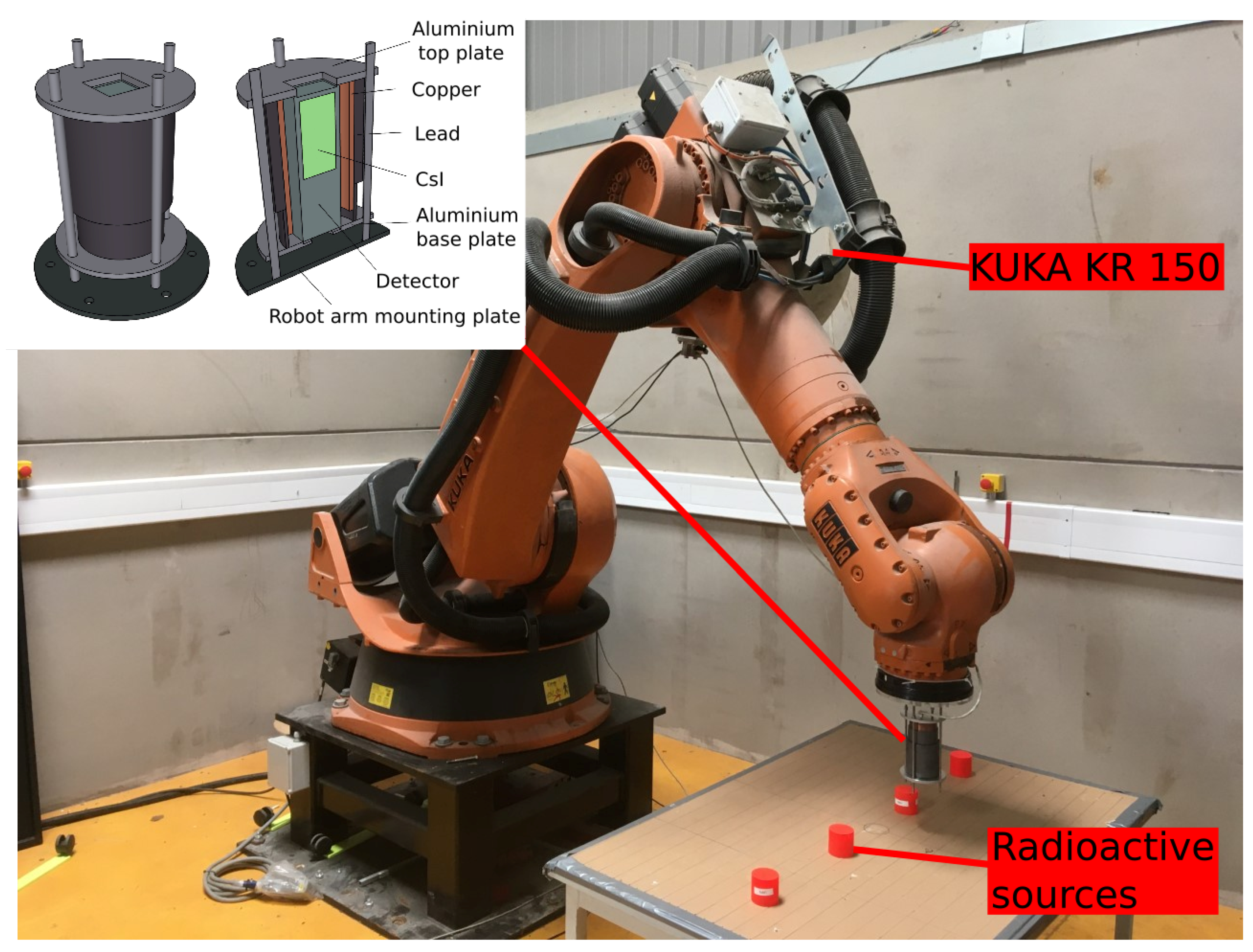
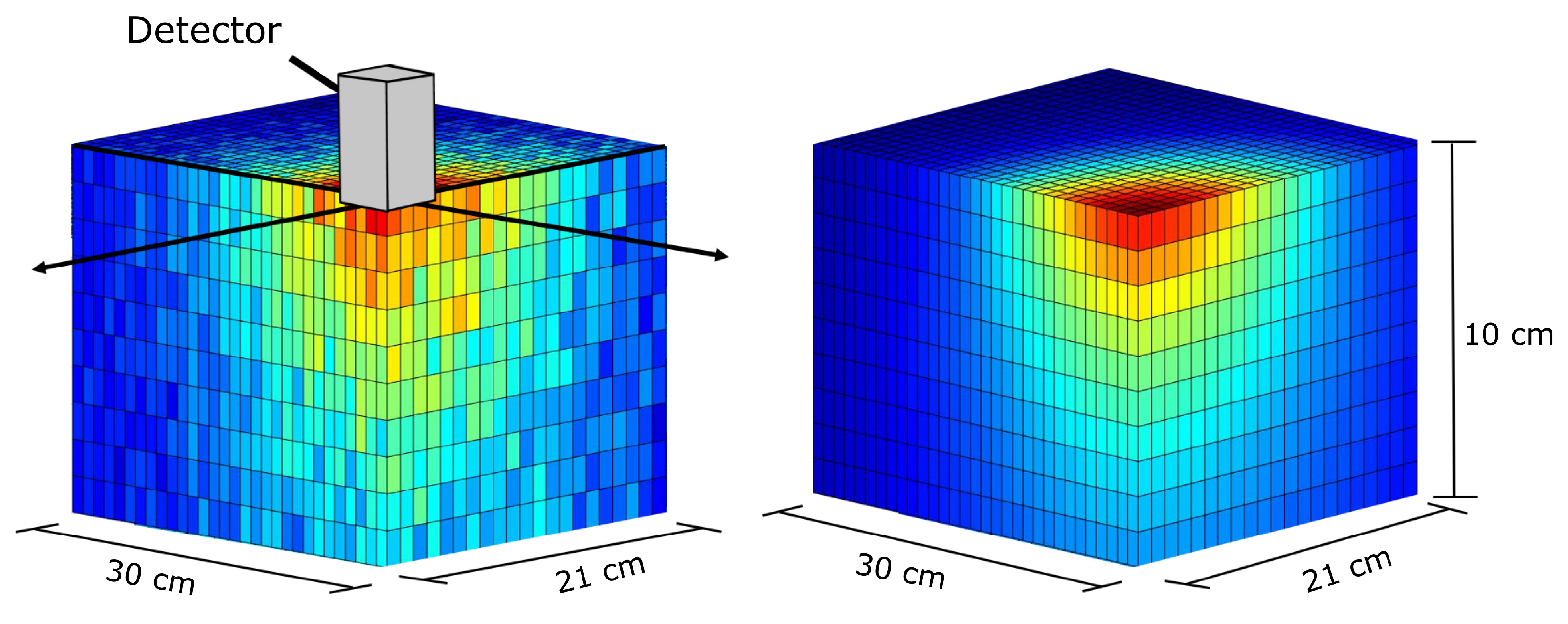
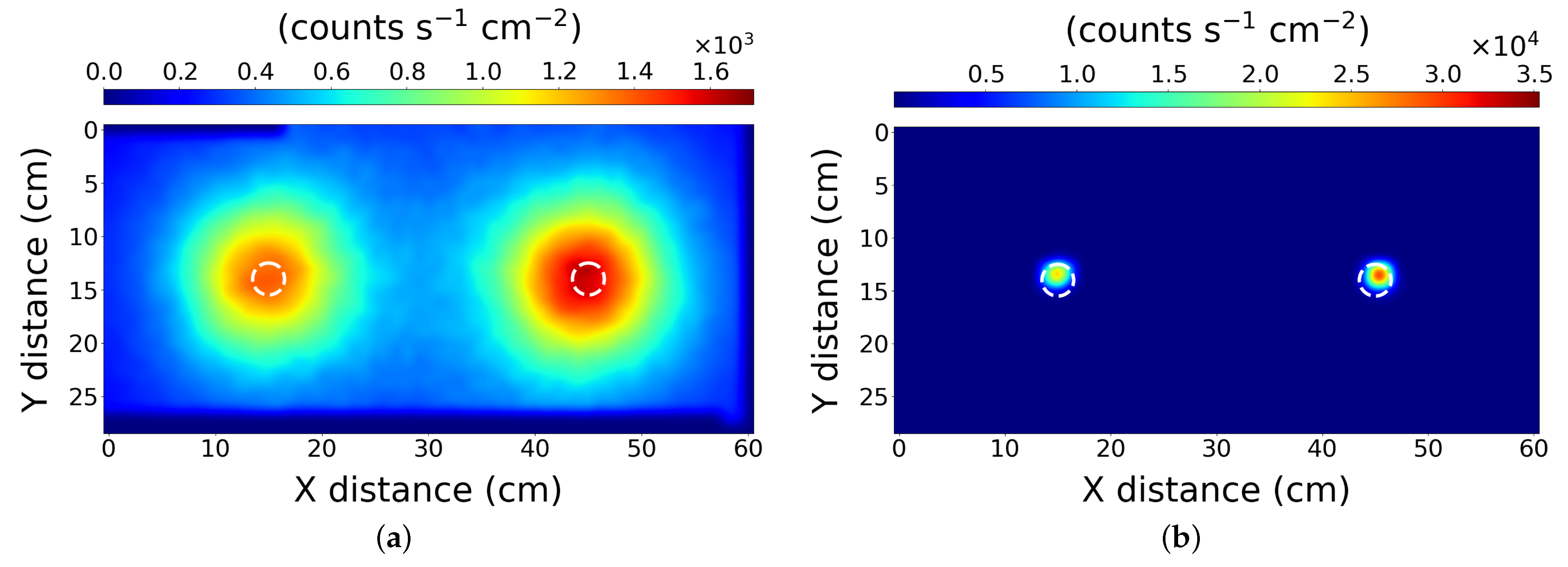


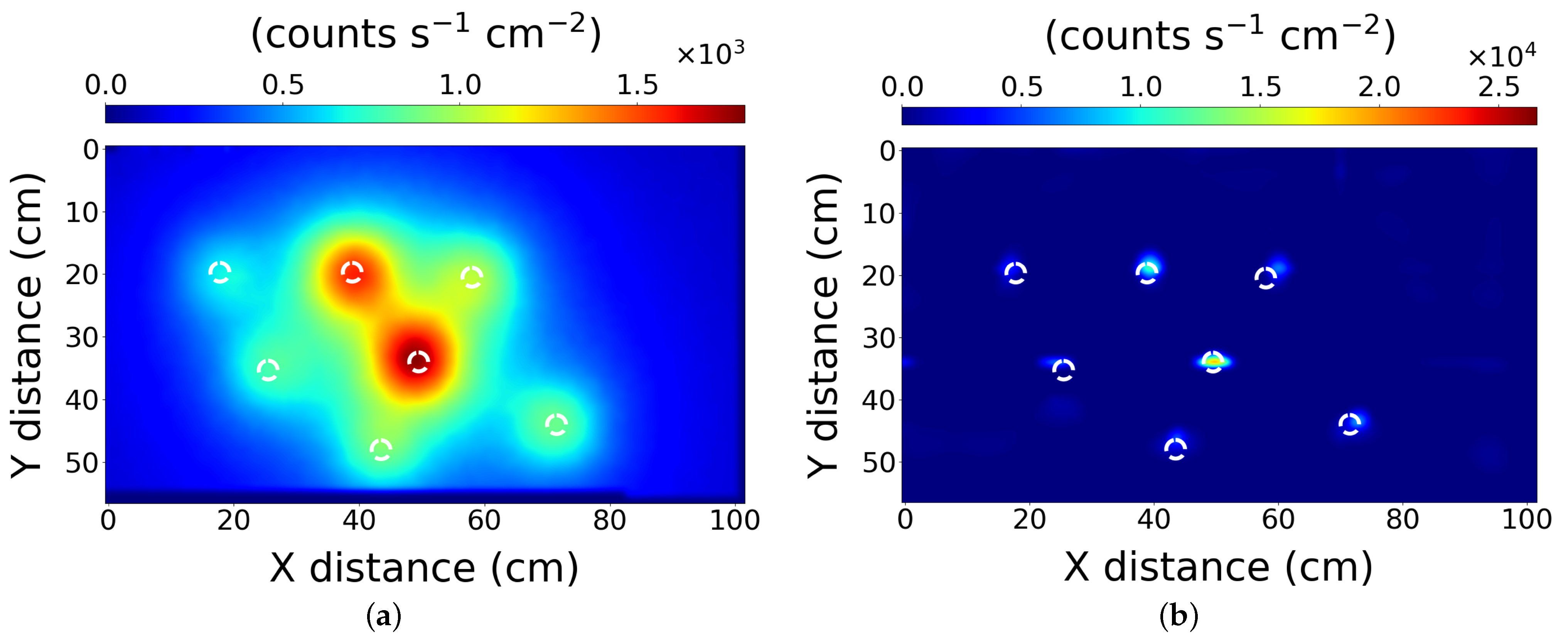

| Volume (m) | |||
|---|---|---|---|
| Waste Category | Reported (as of 1 April 2019) | Estimated Future Arisings | Lifetime Total |
| HLW (>10 GBq/kg) | 2150 | −760 * | 1390 |
| ILW(<10 GBq/kg) | 102,000 | 145,000 | 247,000 |
| LLW (<12 MBq/kg) | 27,400 | 1,450,000 | 1,480,000 |
| VLLW (<100 kBq/kg) | 1040 | 2,830,000 | 2,830,000 |
| Total | 133,000 | 4,420,000 | 4,560,000 |
| Type | Activity (kBq) | X Pos. (cm) | Y Pos. (cm) | |
|---|---|---|---|---|
| Scenario 1 | Cs-137 | 31.0 | 15.0 | 14.0 |
| Cs-137 | 36.0 | 45.0 | 14.0 | |
| Scenario 2 | NORM | 2.9 | 13.0 | 12.5 |
| NORM | 4.7 | 41.0 | 14.0 | |
| NORM | 2.7 | 71.0 | 14.0 | |
| NORM | 3.0 | 97.0 | 14.5 | |
| Scenario 3 | Cs-137 | 36.0 | 23.5 | 10.0 |
| Cs-137 | 31.0 | 35.5 | 10.0 | |
| Scenario 4 | NORM | 6.11 | 71.5 | 44.0 |
| NORM | 1.38 | 58.0 | 20.5 | |
| Cs-137 | 31.0 | 38.9 | 19.7 | |
| Cs-137 | 36.0 | 49.5 | 34.0 | |
| NORM | 1.21 | 43.5 | 48.0 | |
| NORM | 3.49 | 25.5 | 35.3 | |
| NORM | 0.97 | 17.8 | 19.7 |
| Source Number (Left to Right) | Standard Deviation Raw Data (cm) | Standard Deviation PLR Data (cm) | Enhancement | |
|---|---|---|---|---|
| Scenario 1 | 1 | 7.8 ± 0.2 | 0.78 ± 0.01 | 10 |
| 2 | 7.6 ± 0.2 | 0.70 ± 0.01 | 10.9 | |
| Scenario 2 | 1 | 8.3 ± 0.3 | 0.98 ± 0.01 | 8.5 |
| 2 | 7.5 ± 0.2 | 1.35 ± 0.01 | 5.6 | |
| 3 | 8.6 ± 0.3 | 1.37 ± 0.05 | 6.3 | |
| 4 | 8.0 ± 0.3 | 1.55 ± 0.04 | 5.2 |
Publisher’s Note: MDPI stays neutral with regard to jurisdictional claims in published maps and institutional affiliations. |
© 2021 by the authors. Licensee MDPI, Basel, Switzerland. This article is an open access article distributed under the terms and conditions of the Creative Commons Attribution (CC BY) license (http://creativecommons.org/licenses/by/4.0/).
Share and Cite
White, S.R.; Wood, K.T.; Martin, P.G.; Connor, D.T.; Scott, T.B.; Megson-Smith, D.A. Radioactive Source Localisation via Projective Linear Reconstruction. Sensors 2021, 21, 807. https://doi.org/10.3390/s21030807
White SR, Wood KT, Martin PG, Connor DT, Scott TB, Megson-Smith DA. Radioactive Source Localisation via Projective Linear Reconstruction. Sensors. 2021; 21(3):807. https://doi.org/10.3390/s21030807
Chicago/Turabian StyleWhite, Samuel R., Kieran T. Wood, Peter G. Martin, Dean T. Connor, Thomas B. Scott, and David A. Megson-Smith. 2021. "Radioactive Source Localisation via Projective Linear Reconstruction" Sensors 21, no. 3: 807. https://doi.org/10.3390/s21030807
APA StyleWhite, S. R., Wood, K. T., Martin, P. G., Connor, D. T., Scott, T. B., & Megson-Smith, D. A. (2021). Radioactive Source Localisation via Projective Linear Reconstruction. Sensors, 21(3), 807. https://doi.org/10.3390/s21030807






